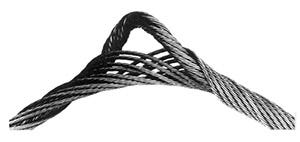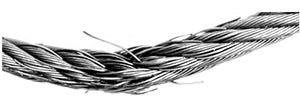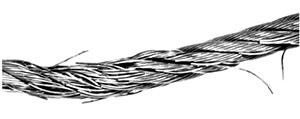COMMON WIRE ROPE ABUSES
Neglect and abuse are the two chief enemies of wire rope life. One costly form of neglect is lack of proper field lubrication. Abuse takes many forms: improper reeling or unreeling, wrong size or worn sheaves, improper storage, bad splicing are a few.
Guidelines for avoiding these common errors can be found on our Wire Rope Use Recommendations page.
Condition of Machinery
Wire rope performance depends upon the condition of the equipment on which it operates; poorly maintained equipment will usually result in reduced rope life.
Effects of Shock-Loading and Vibration
The destructive effects of jerking or shock-loading are visually noticeable. Vibration has somewhat the same effect, and is equally destructive. An individual shock may be slight but many rapidly repeated slight shocks can have the effect of several large shocks.
Vibration which occurs directly above a load is often unavoidable. “Whipping” of the section of rope immediately above the load is also common. In these cases, rapid wire fatigue is possible. For reasons of safety, this section should be examined regularly.
Wire rope failure is usually cumulative. Each repeated overstress brings the rope nearer to failure. Thus, a wire rope may become fatigued to a point close to failure under a heavy load and actually fail under a much lighter load.
Overstressing
In any hoisting operation, there should be no slack in the wire rope when the load is applied. Otherwise, the resulting stress will be excessive.
Overstressing can also be the result of too-rapid acceleration or deceleration. Wire rope will withstand considerable stress if the load is applied slowly. As with ordinary twine, a quick snap will cause overstressing and breakage. This applies both when starting to lift a load, and when bringing it to a stop.
Corrosion
Corrosion can seriously shorten wire rope life, both by metal loss and by formation of corrosion pits in the wires. These pits act as stress-concentration points in the wires in much the same manner as do nicks.
Wire rope left on machines shut down for long periods of time deteriorates rapidly. To preserve the rope for future use, it should be removed, cleaned and thoroughly lubricated.
Pitting, erosion, and surface effects of many different types can all result in corrosion damage. Because they tend to increase corrosion, the following conditions should be considered and noted when applicable, during the ordering of wire rope - acid and alkaline solutions, gases, fumes, brine and salt air, sulphurous compounds, and high humidity and temperature. Lubricants are readily available to reduce the severity of attack of most of these conditions.
Effects of Severe Heat
Where wire rope is subjected to severe heat (e.g., foundry cranes) it will not give the service expected because it will deteriorate more quickly. Wire ropes exposed to hot-metal handling or other extreme heat sometimes require independent wire rope cores.
Shifting Ropes From One Job to Another
Sometimes an idle wire rope from one operation is installed on another to keep the rope in continuous service. This extremely poor practice is an expensive economy.
Because wire rope tends to “set” to the conditions of its particular operating job, the differing bends, abrasions, and stresses of a new operation can produce premature failure. Therefore, for maximum life and efficiency, a rope should be used only on the job for which it has been specified.
Machinery Operation
Some operators are harder on their machinery than others and as a result they get shorter rope life. In certain instances, enough extra work is done to more than offset the additional wear-and-tear on equipment and wire rope. The operation may be more efficient from the production standpoint as a result, but those in charge of rope purchases should be made aware of the probable reduction in rope life and increased rope costs.
Block Twisting
Block twisting or “cabling” is one of the most frequently encountered wire rope problems in the construction field. When this problem occurs, the wire rope is most often blamed, and other equally important factors in the operation are overlooked.
Personnel experienced with handling of wire rope know that conventional wire ropes will twist or unlay slightly, when a load is applied. In a reeved hoisting system, subjected to loading and unloading, such as a load hoisting line, this results in block twisting and possibly distortion of the wire rope.
Cabling of the block most frequently occurs as the load in the wire rope is released, and the "falls" are in a lowered position. Cabling may be considered as the twisting of the block beyond one-half of a revolution (180O twisting) of the traveling block.
When this condition occurs, the operator shows good judgment in not making additional lifts, until the conditions causing the problem are corrected.
The following machine and site conditions should be investigated for possible improvement in block twisting:
- Reduce wire rope length. Longer rope lengths cause more twisting than short rope lengths. This applies particularly to the amount of wire rope in the “falls.”
- Reduce the amount of load lifted. Heavily loaded ropes have more torque and twist than lightly loaded ropes. This condition would also apply to the speed of loading or “shock” loading, since this condition also causes higher wire rope loading.
- Eliminate “odd-part” reeving, where the wire rope “dead-end” is on the traveling block. Wire rope torque, from the application of load, is greatest at the rope dead-end.
- Relocate the rope dead-end at the boom, in order to increase the separation between the dead-end and the other rope parts. This applies a stabilizing load directly to the traveling block. The original equipment manufacturer should be consulted before making this modification.
- Increase sheave size. This increases the amount of separation between wire rope parts and may improve the situation by applying stabilizing loads and reducing the amount of rope torque transmitted to the traveling block.
- Restrain the twisting block with a “tag” line. One or more of the foregoing suggestions
may eliminate the problem without resorting to “specialized” wire rope which may not
only be difficult to locate but expensive as well.
The use of special “rotation resistant” wire ropes will not likely be required unless the intended length of rope “falls” exceeds 100 feet, or the length of the load hoisting line exceeds 600 feet. In the event these latter conditions exist, the user should also anticipate using a combination of the “rotation resistant” wire rope and the foregoing field suggestions for the more severe problems.
Examples of Common Wire Rope Abuses

Crushing. Because of loose winding on drum, rope was pulled in between underlying wraps and crushed out of shape.

Sudden load release. The sudden release of a load causes birdcaging. Here individual strands open away from each other, displacing the core.

Lack of lubrication. Premature breakage of wires resulted from"locking" of strands, which was caused by insufficient lubrication.

Infrequent inspection. Neglect of periodical inspection left this rope in service too long, resulting in considerable abrasion.

Improper handling. Kink or "dog leg" was caused by improper handling and/or installation. A kink causes excessive localized or spot abrasion.

Reverse bending. Running this rope over one sheave and under another caused fatigue breaks in wires.

Excessive exposure to elements. Too much exposure combined with surface wear and loss of lubrication caused corrosion and pitting.

Too long in service. Repeated winding and overwinding of this rope on a drum while under heavy stress caused the unusually severe wear shown.

Undersize sheave grooves. Sheaves were too small, causing strands to pinch. Wires then fail in the valley between the strands.

Poor work procedures. Damage to strands and wires resulted from electric arcing.

Lack of knowledge. Here's what occurs when a loop which has been "pulled through" and tightened remains in service.




